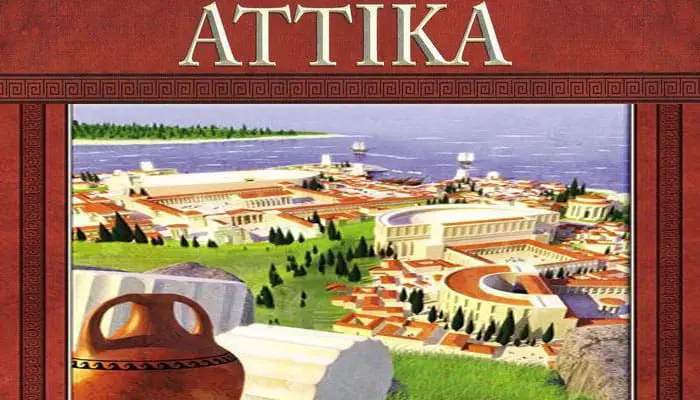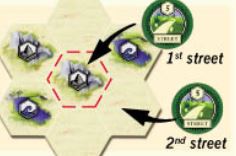
Each player oversees the building of his city-state. Temple, theater and oracle, a harbor with ships, vineyard with vintner, and many more must find space on the greek peninsula.
Players must move fast to get the best land for themselves while blocking their opponents from good building spots.
As building is expensive, players seek to save money by using the natural resources of the peninsula. Players also seek to organize their building in an order that allows building for free.
Components
- 22 game board tiles
- 4 shrines
- 5 amphore
- 4 player storage boards
- 120 building tiles
- 60 landscape cards
Setup

Before the first game, carefully remove the game board tiles, building tiles, and shrines from their frames. Put together the 4 shrines from their 2 parts (see above).
Shuffle the game board tiles and place them face down in a stack away from the middle of the table. Depending on the number of players, draw 4, 6 or 8 game board tiles and place them face up in the middle of the table as shown below.

Depending again on the number of players, place 2, 3. or 4 shrines netxt to the game board tiles (see above).
Place the amphore to the side in a pile.
Each player chooses a color and places the player board of that color in his play area (the space before himself). Each player takes the 30 building tiles in his color.
Note: For simplicity, all tiles are called buildings, even corn field, ship, road, etc..
Each player sorts out the 6 main buildings (black symbol on back), shuffles them face down, and places them in a stack next to his player board. Each player shuffles his remaining 24 building tiles face down and places them face down in 3 stacks of 8 buildings each next to his player board.
Each player draws the top-most building from each of his 4 stacks and places them face up on the corresponding spaces on his player board.
Shuffle the 60 landscape cards and place them face down as a supply away from the middle of the table.
The players choose a starting player. The starting player draws 4 landscape cards as his starting hand. His left opponent draws 5 cards, the next player draws 6 cards (with 3 or 4 players), and the next player draws 7 cards (with 4 players).
Object of the Game
The winner is the first player:
- to place all 30 of his buildings on the game board or
- connect any two shrines with his buildings

Game Play
The starting player begins and the players continue in clockwise order.
On a player's turn, he either draws 2 new buildings or builds 3 buildings from his player board.
Draws
The player draws 1 building from any of his building stacks and looks at it.

If he wants to spend the cost to build it, he pays the building cost an places it on the game board.
Otherwise, he places it on the corresponding space on his player board.
When a player chooses the draw action, he does it twice.
Builds

The player takes 1 building of his choice from his player board, places it on the game board, and pays the building cost.
When a player chooses the build action, he does it thrice.
After the player has drawn twice or built thrice, his turn ends.
Note: a player may not us the draw action and build action in the same turn.
Draw Landscape Cards

When can a player draw landscape cards?
A player may choose to forsake all or part of his draw or build actions to draw landscape cards. For each draw or build action he forsakes, he draws 1 landscape card from the supply, adding it to his hand.
Example: the Sparta player chooses to build on his turn. First, he builds a fortress on the game board. Instead of further builds, he draws 2 landscape cards, adding them to his hand. Had he used the draw action and drawn a fortress, he could then draw only 1 landscape card.
If a player forsakes all draw/build actions he draws 3 landscape cards.
Notes: The player must always draw landscape cards after he has taken all draw or build actions he wants. A player may not draw landscape cards and then take draw or build actions. The hand of landscape cards is not limited to a certain number.
When the landscape card supply is exhausted: shuffle the landscape discard stack and place it face down as the new supply.
Building Rules
Building Space
Where can a player build a building?
A player may build a building on any empty space on the game board, regardless of whether the space has a landscape symbol or not. A player may not build a building on a shrine or a space that already has a building.
Building Cost
The cost of a building is shown in landscape symbols on the building tile itself and also on the player board.
From the building cost, the player may reduce his payment by the landscape symbol shown on the space he builds and by each landscape symbol shown on empty spaces directly adjacent to the building space.
The player pays the remaining cost with corresponding landscape cards from his hand. He places these cards face up on the discard stack.
He may play any 2 landscape cards in place of a required landscape card.
Building for Free
A player can completely eliminate the cost to build a building by building it in the right order

The arrows on the player boards depict the free building order. To build for free:
- The player's building, from which an arrow points must already be on the game board. /
- The player builds his building pointed to by the above building directly adjacent to the above building.
Example: the Corinth player builds his tower directly adjacent to his fortress, paying nothing to build the tower as it is pointed to by the fortress on his player board.
In the following cases, players may not build for free:
- Inverse: the tower has been built and the player builds the fortress.
- +Skipped building; the quarry has been built and the player builds a tower.
- Wrong player: the player builds a tower next to an opponent's fortress.
- Main building (white words on black background): there exists no right order for main buildings.
Building Streets

To build a street, a player must pay any 5 landscape cards, reduced by the landscape symbol shown on the space he builds and by each landscape symbol shown on spaces adjacent.
Building for free: a player may build a street for free when he builds it directly adjacent to one of his streets.
Example: the player builds his first street on the space shown, reducing his cost by 2 mountains and 2 water. He pays 1 landscape card of his choice. Later in the game, he builds a second road adjacent to his first road for free.

Settlements
What is a settlement?
A settlement is one or more connected buildings of the same player color. A player founds a new settlement when he builds a building that is not directly adjacent to any of his other buildings.
When a player founds a new settlement, he pays a new settlement cost in addition to the building cost. The new settlement cost is 1 of any landscape card for each other settlement the player has.
Example: the Thebes player already has 2 settlements. He builds a road on the space shown, founds a new settlement, and must pay an additional 2 landscape cards.
Notes: a player may connect two or more of his settlements with a building, & reducing later new settlement costs. Buildings connected only through a shrine are not in the same settlement.

Amphore
Each building belongs to one of 7 groups (e. g. defense Oder shipping).
When a player builds buildings from one of his groups together, he earns amphore, which can be used to extend the length of his game turns at appropriate times.
Groups

Which buildings belong to a group?
On the player boards, the buildings of each group are shown together.
For example, quarry, fortress, and the two towers belong to the defense group.
When a player builds all buildings of a group such they are connected to each other on the game board, he earns a reward of 1 amphora, which he may use immediately or save in his play area until later.
Example: the Corinth player builds his quarry such that he now has all 4 buildings in the defense group connected. He takes an amphora from the supply, places it in his play area, and completes his normal turn.
When the supply of amphore is exhausted: The player draws a landscape card, placing it in his hand.

Extend Game Turn

The player puts 1 amphora back in the supply and may take 1 additional draw (when he chose draw for this turn) or 1 additional build (when he chose build for his turn).
An amphora may also be used to draw 1 landscape card.
Reminder: a player may not draw or build after drawing a landscape card.
Example: the Corinth player draws a quarry and a tower, he then puts 1 amphora back in the supply and draws another building. Finally, he puts another amphora back in the supply and draw 1 landscape card.
Note: a player may use as many amphore in a turn as he wants (and has), including those he earns during the turn.
Expand Game Board

When can the game board be expanded?
When a player draws the last building tile from one of his 4 building stacks, he first places the tile on the game board, paying the building cost, or places the tile on his player board.
Then, he draws a game board tile from the stack and adds it to the game board. He may place the tile in any onentation he chooses.
Where may he place the board game tile?
A player must place the game board tile such that it is adjacent to at least one other game board tile or 1 shrine. The game board tiles may ' be placed such that there are holes in the game board. Players may not < place game board tiles on top of shnnes or other game board tiles. Buildings may be immediately placed on new game board tiles.
When the stack of game board tiles is exhausted: the player continues his turn without placing a new game board tile.

End of the Game
A player wins the game, when he is the first player to either place all 30 of his buildings on the game board or to connect any two shrines with a string of his connected buildings.
The game ends immediately when a player wins.
Reminder! Things often forgotten in a first game
A player may play 2 of any landscape card instead of 1 required landscape card.
When a player founds a new settlement, he must additionally pay the new settlement cost.
When a player has built an entire group so that it is connected, he earns 1 amphora.
When a player draws the last tile from a building stack, he places a new game board tile.
Continue Reading

